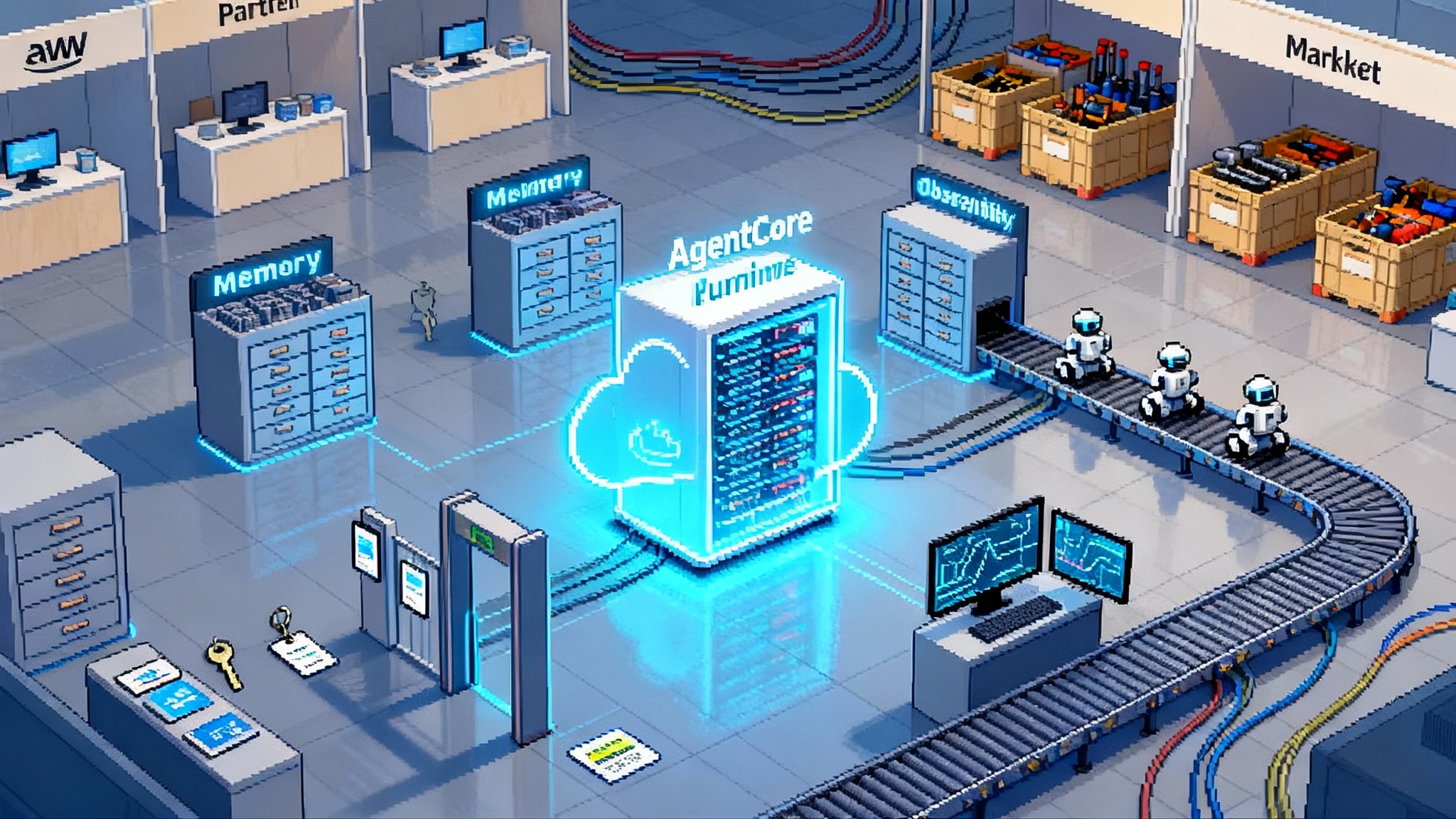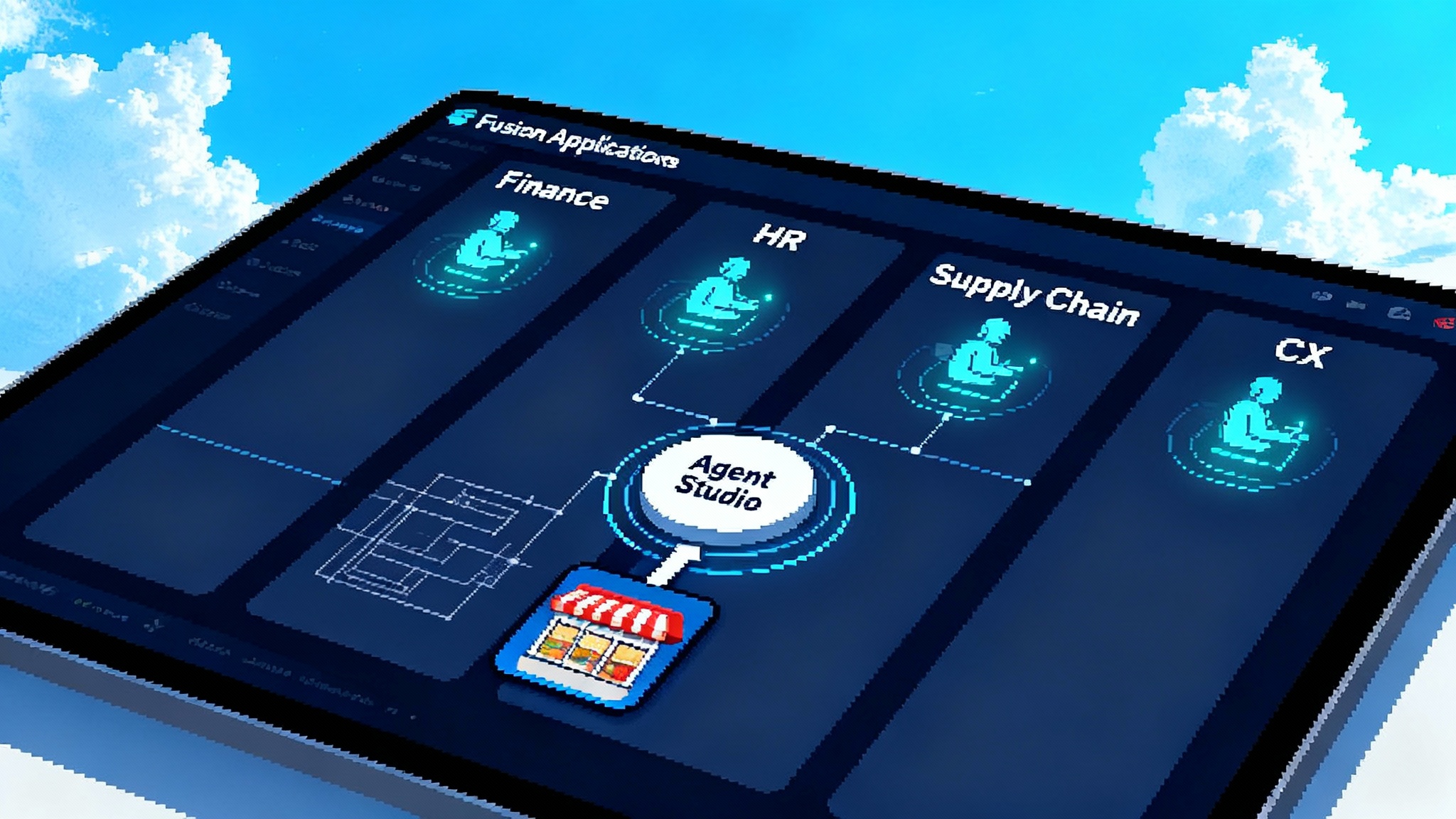AWS turns AgentOps into a cloud primitive with Bedrock AgentCore
On July 16, 2025, AWS launched Bedrock AgentCore and a new marketplace for AI agents, bundling runtime, memory, identity, and observability. Here is how that shift accelerates real enterprise deployments in two quarters.

The day AgentOps became an AWS primitive
On July 16, 2025, Amazon Web Services made a clear bid to turn agent operations into standard cloud plumbing. The company unveiled Bedrock AgentCore, a set of services that give artificial intelligence agents a managed runtime, durable memory, identity-aware access, and production-grade observability. AWS paired it with a new way to find and deploy agents and agent tools through AWS Marketplace. The signal was unambiguous: the era of proof of concept agents is over, and the era of production agent systems has started. You can read the official announcement for the core platform in the Bedrock AgentCore introduction.
Think about this shift with a simple metaphor. For the past two years, many teams built agents like tinkering in a garage. The projects were clever and promising, but every group hand assembled its own wiring for credentials, logging, storage, and tool adapters. AWS is effectively saying: bring those projects into the factory. The factory has assembly lines, safety rails, inspection stations, and a shipping dock. In cloud terms, that means uniform runtimes, consistent identity, first class metrics, and procurement paths that your finance team already understands. If you have been waiting for a clean, auditable way to move from demo to deployment, this is it.
AgentCore in plain language
AgentCore is not one product. It is a set of modular services that you can use together or separately. Each addresses a pain point that derails agents at scale. Here is how to explain the pieces to an executive or a developer who has not lived inside agent frameworks for months.
-
Runtime: a managed execution environment that places every agent session in its own sandbox and supports long running work. This matters when an agent must orchestrate a multi step task across several tools. The runtime aims for low latency while keeping sessions alive for complex plans, so you do not have to duct tape external workers or message queues for anything beyond a single prompt.
-
Memory: the agent equivalent of a notebook and a filing cabinet. Short term memory keeps immediate context. Long term memory stores durable knowledge about users, accounts, and prior tasks so repeated work does not start from zero. AgentCore abstracts the storage and retrieval plumbing and lets you tune what to keep, what to forget, and how to age information.
-
Identity: the bridge that lets agents act on behalf of a user or as a service without leaking secrets. Integration with enterprise identity providers such as Amazon Cognito, Microsoft Entra ID, and Okta means you can map agent actions to real permissions. That enables solid audit trails and a clean separation between what the user can do and what the agent is allowed to do when it calls other systems.
-
Observability: the control room. Every step in a plan, every tool call, and every error needs to be traceable. AgentCore surfaces metrics and traces through familiar AWS monitoring, including Amazon CloudWatch, and supports open tracing standards. This is not decoration. Enterprises do not deploy agents that cannot be measured. Debugging one wayward tool call in a thousand is impossible without end to end visibility.
-
Gateway and tool adapters: the connective tissue. AgentCore Gateway turns existing APIs and services into agent compatible tools and allows agents to discover and call them with a standard protocol rather than a pile of custom adapters. There are also built in tools such as a secure browser environment and a code interpreter, which give agents safe ways to browse or run snippets of code.
Together, these parts let a team focus on the behavior of the agent rather than on scaffolding. If you have shipped software on AWS, the mental model will feel familiar. Runtime is your compute. Memory is managed state. Identity is based on the same security model you already use. Observability slots into the dashboards your operations team already trusts.
Distribution and interoperability land together
AWS did not stop at operations. It also launched a new category in AWS Marketplace that highlights AI agents and agent tools from partners, with direct paths to run them on AgentCore or connect to them through AgentCore Gateway. That means buyers can search for a task, evaluate options, and deploy with the procurement rails they already use. The marketplace listings call out support for interoperability standards such as the Model Context Protocol and agent to agent messaging, so you can filter by fit to your stack. See the details in AWS’s announcement of AI agents and tools in AWS Marketplace.
Interoperability is the underappreciated unlock. The Model Context Protocol defines how agents and tools can talk in a consistent way. If your procurement team can buy a remote tool from a partner and your agents can talk to that tool over a standard protocol, you avoid the bespoke glue code that collapses under load or breaks each time a vendor ships an update. It also makes cross agent orchestration practical. An agent that supervises other agents can be implemented with clear interfaces instead of fragile prompt conventions. This is the same distribution story we have seen elsewhere, from enterprise agent distribution to marketplaces that standardize packaging and billing.
The practical result is speed. Instead of building another ad hoc connector to a work management system or a document repository, you point AgentCore Gateway at a compatible target, authorize it with identity you already manage, and call it. Your teams will spend fewer cycles debugging webhooks and more time designing high value tasks.
What the timing means for roadmaps
Enterprises tend to plan in quarters and roll out in half year cycles. The July 16 launch landed in the first month of the third quarter. Two things happened at once: the operational stack for agents became a managed service, and a distribution channel for agent compatible tools appeared. The combination changes sequencing for the next two quarters in a direct way.
-
Quarter 3, 2025: assess and prototype. Security and platform teams can approve AgentCore patterns faster because identity, logging, and isolation look like the rest of their AWS estate. Application teams can prototype against real observability and real identity rather than placeholders. Marketplace listings reduce the time to find a vendor tool for a specific task. Your output by quarter end should be a short list of candidate agent workloads that have a clear cost model and a risk register tied to observed metrics.
-
Quarter 4, 2025: harden and roll out. With the control plane and procurement path in place, teams can push pilots into limited production. The gating items move from questions about runtime and logging to questions about the tool catalog and the right human-in-the-loop controls. Many organizations will pick one horizontal use case, like an internal triage desk, and one vertical use case, such as invoice exception handling in finance. Both are realistic on AgentCore with identity and observability wired in from day one.
For leaders, the minimum viable plan is to approve a reference architecture, a procurement path, and a small portfolio of tool targets by the end of the current quarter. That unlocks real deployments next quarter without reopening security debates.
What startups should do next
Startups rarely win by boiling the ocean. The new environment favors a few focused strategies.
- Become the tool every agent needs
- Pick one painful enterprise task. Examples: pulling customer entitlements from multiple systems, converting procurement emails into structured orders, or reconciling tax codes across jurisdictions.
- Publish a Model Context Protocol compatible service with tight scopes and strong idempotency. Make it easy to call, easy to test, and easy to retry.
- List in the AWS Marketplace category so buyers can try with their existing account. Offer usage based pricing with clear tiers and sample cost calculators. Ship templates that show how to attach your tool to AgentCore Gateway.
- Add identity aware authorization from the start. Let buyers decide whether the agent acts as a user or as a service, and document the tradeoffs.
- Package a full agent for a vertical
- Pick a bounded workflow where your domain knowledge is the differentiator. For example, an underwriting precheck copilot that gathers documents, validates completeness, and fills a checklist before a human sees the case.
- Run on AgentCore Runtime for the long lived sessions, use AgentCore Memory for case context, and surface every step in CloudWatch. This should look and feel like real enterprise software, not a demo bot.
- Include safe defaults for human review and rollback. Enterprises buy agents that never go silent and always explain what they did.
- Stitch the enterprise together
- Offer orchestration and governance services for multi agent setups. The moment a customer has three agents and six tools, someone needs to design traffic shaping, quota management, and incident response playbooks.
- Sell this like any managed platform service. Show up with dashboards, synthetic tests, and on call rotations, not just architecture slides.
A useful orientation for founders is to treat AgentCore as a distribution and compliance layer. Build your capability on top and let AWS handle the repetitive control plane work. If you need a primer on moving from experiments to production-grade components, study how others bridged that gap with platforms like AgentKit from demo to deployable.
Reference architectures you can copy
These patterns are based on the pieces AWS just made available and the way enterprises already deploy software.
-
Human in the loop knowledge agent
- Use AgentCore Runtime to manage a session for each ticket.
- Wire AgentCore Memory to capture retrieved artifacts and explanations.
- Connect AgentCore Gateway to document stores and a search tool that supports the Model Context Protocol.
- Route every proposed action through a review queue with clear accept or edit choices.
- Observe with CloudWatch traces that show retrieval paths and confidence summaries.
-
Finance exception handler
- A supervisor agent receives exceptions from the enterprise resource planning system.
- It uses AgentCore Gateway to call partner tools in AWS Marketplace for vendor validation and tax lookup.
- Identity policies restrict write actions to a service role with limited scope, while read actions can impersonate the submitting user.
- Every resolved exception is attached to an audit bundle that includes the tool calls and the reasons for each step.
-
Ecommerce catalog fixer
- An agent detects broken or incomplete product pages.
- It uses the secure browser tool to test pages and the code interpreter to patch small issues in templates.
- For price changes, it raises a change request that a human approves. The request includes a cost impact simulation and every external data source consulted.
These patterns reuse the same ideas. Put each session in a box. Manage memories. Keep identities explicit. Send all the signals to observability. When tools are outside your account, use a protocol rather than a one off adapter.
Metrics and risks to watch
Agent systems live or die by a handful of numbers. Put these on a dashboard before you scale.
- Task completion rate: the percentage of sessions that end with the intended outcome. Break it down by tool.
- Cost per successful task: model inference, tool calls, and compute time divided by tasks that actually finish.
- Tail latency: the 95th percentile time from first prompt to final action. Long tails kill user trust.
- Memory freshness: the ratio of useful hits to stale or wrong hits. Stale memories lead to quiet failures.
- Escalation ratio: how often the agent asks for help. High escalation can be good if it prevents bad actions. It is bad if it reflects brittle plans.
- Audit completeness: the share of sessions with full traces and signed actions. Anything less is a risk during an incident review.
The biggest risks are not mysterious. Identity misconfiguration that grants agents more power than intended. Tool drift where a partner changes an API and your agent fails in silence. And prompt rot where capabilities erode over time because the system forgot to monitor key steps. AgentCore reduces these failure modes, but it does not eliminate them. Treat agents like production services and you will avoid most disasters.
Competitive and ecosystem context
By moving AgentOps into managed services and into the marketplace, AWS is stretching its network effects. Vendors can sell working agent parts that plug into a standard control plane. Buyers can estimate risk and cost in familiar terms. Open frameworks and models can plug in without special favors. The company is also aligning with interoperability through the Model Context Protocol and agent to agent patterns, which lowers switching costs for customers and broadens the partner pool.
Expect more vendors to announce marketplace listings that state protocol support and ship templates for AgentCore. Expect consulting firms to package reference architectures and bake observability dashboards into their offers. Expect enterprise procurement to ask whether a proposed agent solution runs on AgentCore and whether it uses marketplace tools rather than custom connectors. These are normal cloud questions, and that is the point. For context on how marketplaces shape adoption, compare with Oracle's marketplace for agents, and for distribution mechanics at the model layer, see how others are approaching enterprise agent distribution.
A 90 day playbook for execution
- Pick two target workflows where latency and accuracy requirements are clear.
- Approve a reference architecture that uses AgentCore Runtime, Identity, Memory, and Observability. Keep the number of tools under five.
- Stand up a single AgentCore Gateway and attach two marketplace tools that support the Model Context Protocol.
- Define rollbacks before you deploy. If the agent fails, who takes over, and what is the path back to a known good state.
- Put a weekly review in place with dashboards. Track task completion, tail latency, and escalation ratio. Kill what does not work by week four.
- Publish a short internal buyer guide that explains how to evaluate marketplace listings, what protocols to look for, and how to request access.
The goal is to build muscle in your organization. You are not trying to prove that agent technology works. You are trying to prove that your team can operate it like any other service.
The bottom line
AWS turned agent operations into standard cloud components and gave vendors a shelf to sell agent compatible parts. That combination changes both how fast teams can ship and how reliably they can run what they ship. The announcement on July 16 did not invent agents. It made them practical to buy, govern, and scale. If you have been waiting for a clear enterprise starting point, you just got it. Pick a use case, draw the guardrails, and ship with real metrics, not vibes.








